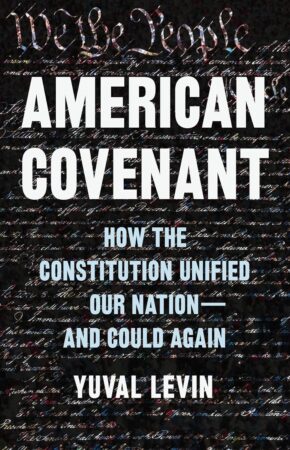Oswald Clark:
American Covenant: How the Constitution Unified our Nation – and Could Again
by Yuval Levin (Basic Books, $41, 341 pages)
 For the last century, the American Left has been frustrated by the U.S. Constitution’s limits on government because, they claimed, it prevented necessary political action to remedy all of life’s ills. In recent decades, some on the American Right have likewise viewed the U.S. Constitution as a straightjacket that impedes it achieving its ends. Enter Yuval Levin of the American Enterprise Institute to give a round of support to the beleaguered U.S. Constitution with an eye to how the document can help the American polity overcome its deep divisions and policy disagreements.
For the last century, the American Left has been frustrated by the U.S. Constitution’s limits on government because, they claimed, it prevented necessary political action to remedy all of life’s ills. In recent decades, some on the American Right have likewise viewed the U.S. Constitution as a straightjacket that impedes it achieving its ends. Enter Yuval Levin of the American Enterprise Institute to give a round of support to the beleaguered U.S. Constitution with an eye to how the document can help the American polity overcome its deep divisions and policy disagreements.
In American Covenant: How the Constitution Unified our Nation – and Could Again Levin, America’s foremost conservative defender of U.S. institutions, argues that “The breakdown of political culture in our day is not a function of our having forgotten how to agree with each other but of our having forgotten how to disagree constructively.” Recovering the original understanding of the division of powers articulated in the U.S. Constitution, created at a time of deep division at the creation of the United States of America, offers hope to heal the fractious American polity three centuries later.
Levin argues that unity and cohesion are less pre-requisites for a country’s survival than products of particular political action. Levin writes “we have grown less capable of dealing with one another because we have embraced an approach to American government that de-emphasizes dealing with one another.” Modern politics is no longer a give-and-take of compromise between factions in society, but the seeking of total victory. The Founding Fathers’ brilliance in writing the U.S. Constitution, on the other hand, was in developing ways that factions could get some of what they want and negotiate the remaining differences. That is what a system of checks and balances provides, and while it frustrates those in power, it encourages – some might argue teaches – fallen human beings to learn not necessarily how to agree to a course of action but how to disagree when a course of action is taken. As Levin argues, the constitutional framework of the U.S. government is “not properly understood as empty procedures” but “the heart of our republicanism,” “a demanding ideal of the human being and citizen.” It recognizes not only mankind’s “fallenness and limitations but also our dignity and our potential.”
The Founders recognized that all men were self-interested and thus factional. Mankind has an innate desire to acquire power and use it against others. The U.S. Constitution is designed to minimize the harm that can be caused to others when one faction has seized power. The system of check-and-balances should inculcate citizens and rulers with a respect for certain democratic and governing norms. The idea of total victory ignores “durable differences that need to be negotiated and assuaged.” More importantly, total victory eschews persuasion to win over converts because using power to bridle or even punish opposition becomes the new norm. American constitutional government seeks to reconcile differences through debate, both between factions within society and their representatives in government, with the various branches of government playing their unique roles.
When one branch of government becomes broken through, for example, the rise of judicial activism, an imperial bureaucracy, or a rhetorical presidency, other branches suffer by amending their processes to the new norms. Levin points out that when the presidency, bureaucracy, and judiciary “take over” all policy-making Congress “breaks down” and the “model of political action and social change – the civic blueprint in our heads – gradually transforms into a less accommodational and more imperious framework and leaves us more inclined to think of politics in winner-take-all terms and less inclined to seek compromise.”
The conclusion of each of Levin’s chapters offer practical, seemingly boring prescriptions for fixing the machinery of government: reforming Congressional committees, reforming to the budget-writing process, scaling back the “extra-constitutional character of ‘independent administrative agencies.” Such reforms, “recovering something of the office’s original function(s),” seem unlikely if not entirely impossible within the current political climate.
Ultimately, it might be argued, it is up to citizens to restore the original structure of the Constitution, and thus “promote unity by enabling negotiation and engagement.” That is no easy task when current politics “tend to intensify division and bitterness,” which is why not only the appointment process of judges but the very Supreme Court has become so intensely political. As Levin says, “Our civic culture and our governing institutions affect each other in a cyclical way” because “institutions and culture shape each other.” That said, Levin argues that institutions are “more readily changeable” and the only real hope for recovering the original intent and meaning of the U.S. Constitution is with transformation leadership, by leaders inspired by the Founding Fathers’ vision of America. (Levin ably weaves the arguments of James Madison and Alexander Hamilton into his narrative.)
Such leadership do not seem imminent. For most of American history, politics was animated by a governing majority coalition and a minority trying to form a coalition to win government. In other words, each side had to work with others not only from the opposing party but, more importantly, within it. Over the past 25 years, American politics has been an evenly split nation with most states voting reliably Republican or Democrat and only about 20 per cent of the population living in states that might be contested by both parties. Political parties have become personality cults, not vehicles for cooperation and coalition building. There is little reason to believe that Americans will learn how to talk to one another any time soon despite Levin’s noble effort to provide a reliable roadmap.




